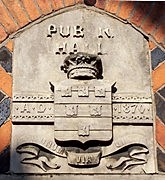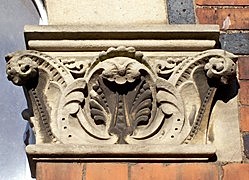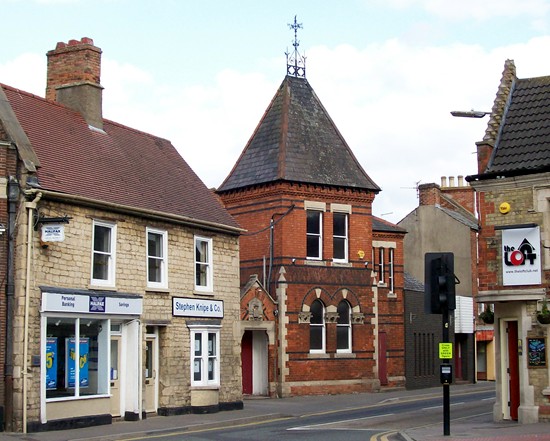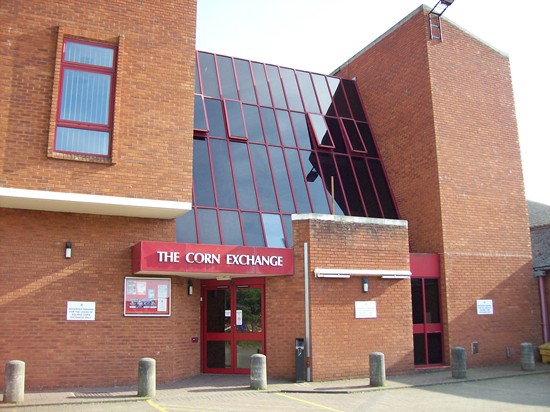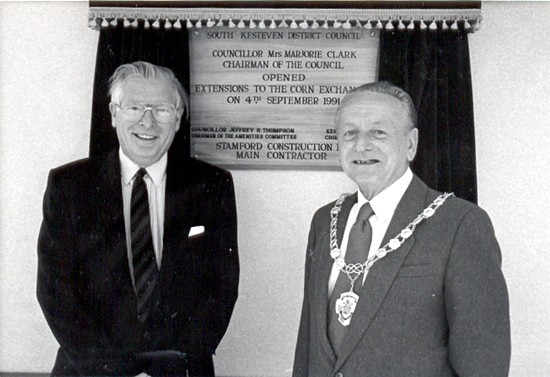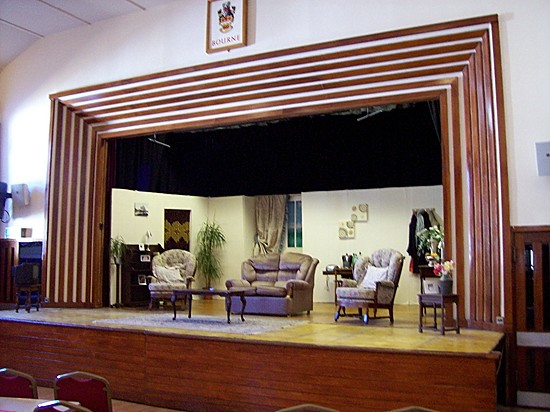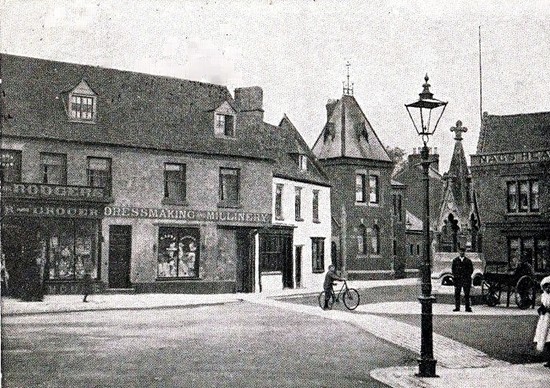|
The Corn Exchange
One of the most enduring buildings in Bourne is the Corn Exchange which was built almost 150 years ago on the site of the old post office where Abbey Road approaches the market place. The premises were owned by the Marquess of Exeter, then Lord of the Manor of Bourne, who had sold the property on favourable terms to make way for the new development and he also promised that a large portion of the proceeds from the sale would be invested in shares for the new enterprise. Trading in corn had been part of the commercial life of Bourne for centuries but it was not until the early 19th century that it became organised. In 1824, landowners banded together to form a new corn market which met every Saturday outside the new Town Hall from 12.30 pm until 1.30 pm. This arrangement coincided with the re-establishment of the weekly fairs and markets in Bourne which took place during the same year and continued successfully for the next forty years when traders decided that a permanent indoor market would be more suitable for the expanding town. The decision to proceed with a new building for this purpose was taken at a public meeting at the Town Hall on 10th February 1870 when local magistrate William Parker of Hanthorpe Hall presided. He said that the object was to obtain a public hall and corn exchange by means of a limited liability company and added; "This is of considerable importance to the town and neighbourhood and therefore I have great pleasure in identifying myself with the project." Parker said that there were three main advantages in the erection of such a building, firstly the establishment of a much needed corn exchange on a proper site, secondly the opening of a reading room and library and thirdly the provision of a suitable room for lectures and concerts, "and in this way to afford instruction and rational amusement to larger numbers than could be accommodated in Bourne at present." Five resolutions were put to the meeting:
All resolutions were carried unanimously and by the time the meeting closed, 250 shares had already been taken up. The architect was Mr Charles Bell, of London, and the contract for the construction work went to Robert Young of Lincoln after his tender of £1,150 was accepted in May 1870 when work began on clearing the site. The building was ready for use by the autumn and the corn market opened for business on October 13th in the large hall where several merchants had already taken stands. The new premises also included a stage and retiring rooms and the hall was capable of seating 500 people and so it was also used for public events, the first of which was the annual ploughing meeting of the Bourne Agricultural Society. Musical and other entertainments could also be held there and the first of these was held the following week. The total cost, however, had risen to £2,000, a sum that included the purchase of the land and the fittings. The result was an unpretentious Victorian building of red brick and stone dressings and a blue slate roof but lacking the sober grace of the Georgian Town Hall just round the corner. "It is hoped that the facilities now offered by its creation, which was very much needed in this town, will lend greatly to the advancement of the market, and the comfort of agriculturalists and others", reported the Grantham Journal. "The hall, with its ante-rooms, is intended to be let for all public and other entertainments, and the company have framed a scale of charges which will be found sufficiently moderate to meet the public requirements. The hall is well situated near the Market Place and is an ornament to the town, and reflects great credit to Mr Bell, the architect." The Corn Exchange was soon in regular business use and the Stamford Mercury reported on Friday 18th November 1870: We are requested to state that the building is a boon to the inhabitants as the large room is ample for all requirements and, being well adapted for a ball, a hope is entertained that arrangements will be made during the winter with this object in view. The opening of the room is said to be likely to increase the market, as 1,500 quarters of wheat were sold on the 10th inst. It is suggested that a meeting of merchants and farmers should be called to decide upon and establish a system of buying and selling corn without "chap money" [a promise to pay rather than a payment] which has caused so much unpleasantness at Stamford. In referring to this matter, a merchant recommends "14 days net cash".
Ice skating as a public pastime was introduced in 1876 at a time when many rinks were being opened around the country and making a profit for those who invested in them. The Stamford Mercury reported on Friday 14th January that as a result, "several gentlemen were accordingly trying to arrange to adapt the Corn Exchange for this simple means of exercise and entertainment". The facility, known as the Bourne Skating Rink, opened the following month and was administered by a committee of management who advertised in the newspaper on Friday 18th February when their news columns commented: "The pastime has become so fashionable of late that there can be no doubt it will find numerous votaries at Bourne." The new activity, however, did have its pitfalls and the Grantham Journal reported on Saturday 26th February 1876: "The now fashionable amusement of rink skating has during the past week been greatly indulged in by the inhabitants of Bourne and neighbourhood and the originators of the two rinks look forward to successful undertakings. The public hall rink was opened on Friday week and patronised by a large and influential company. Like most recreations, however, this is attended by a degree of danger and we regret to add that an accident happened on the above day to Mr R Wherry, whereby he sustained a fracture of the wrist." In 1889, the Corn Exchange was struck by lightning although no serious damage was done. The incident was reported in the Stamford Mercury on July 26th which said: On Sunday evening, a thunderstorm of unusual severity passed directly over the town while divine service was being held at the church. About 7 o'clock, it grew very dark and the storm broke with terrible violence. The flashes of lightning were extremely vivid and the peals of thunder following each other in rapid succession, were deafening. The vane on the Corn Exchange, to which the point of the lightning conductor is attached, was bent, falling about five inches, and the wire was twisted throughout its length. A passerby noticed a flash of light run from the point to the earth. No further damage occurred to the property as far as we have been able to ascertain and no person was injured. The Bourne Public-hall and Corn Exchange Company Limited was wound up in June 1938 when the building was bought for £1,100 (£53,000 by today's values) by Bourne Urban District Council who had used it as a council chamber since its formation in 1899. Then, under the local government re-organisation of 1976, ownership passed to South Kesteven District Council who are the current administrators. It has therefore served the town well as a public hall and as a venue for a variety of social and business functions, including periodic exhibitions organised by the Chamber of Trade which did much to attract customers to the town's shops at a time when competition for retail trade from nearby towns and cities was becoming particularly acute. During the centenary year, Councillor John Wright, chairman of Bourne UDC, said in a speech at the Corn Exchange at the annual civic dinner on Friday 19th May 1970: "This building has in the past been the hub of the agricultural community, providing essential services for farmers, corn merchants and citizens. Today, the Corn Exchange is a real centre of community and it is particularly gratifying to welcome the representatives of so many of the town's organisations and firms to celebrate not only this civic occasion, but the building's centenary year." A move to close the Corn Exchange was made at a meeting of Bourne Urban District Council on Tuesday 12th February 1969 when Councillor Lorenzo Warner proposed that the building should be sold for conversion into a supermarket and the proceeds used to finance a new town drainage scheme following severe flooding the previous year. He said that the issue should be settled with a referendum to decide whether electors wanted a well drained town or continue to subsidise social and cultural activities. "In all businesses, the right thing to do is to cut out all unprofitable waste and the Corn Exchange has been a very big charge on the rates for the last decade", he said. "In the years 1952-1967, a loss of £7,999 is shown. Has the Corn Exchange outlived its usefulness?" Councillor Warner suggested that school halls should be used as public meeting places out of school hours to encourage the social and cultural life of the town and added: "The use of the Corn Exchange has to meet intense competition and I cannot see how the town can afford the luxury in these days of high rates. More benefit would accrue from providing a well drained town than continuing to meet the very heavy losses from retaining the Corn Exchange." The suggestion received overwhelming and even hostile opposition from other members of the council who pointed out that the Corn Exchange was providing a valuable service for a town with a population of 5,500 and that the costs involved were reasonable in return for the benefits that resulted and in the previous five months, the building had been let 112 times. "I think that Councillor Warner has his priorities wrong", said Councillor G H Astley. A motion that the Corn Exchange should not be sold was carried, with only Councillor Warner dissenting. The acrimony generated by his proposal did not however last because he was eventually elected chairman of the council for the year 1970-71. Major alterations were carried out to the building in 1972 when a new entrance was added and the old council chamber re-modelled as a foyer, new cloakrooms and a bar. The kitchen was modernised and in the main hall, alterations were made to the proscenium arch over the stage, the lighting and the general decor. The pyramid-style blue slate roof of the 19th century marks the last remains of the old building from 1870. In 1990, the Corn Exchange and its facilities were completely rebuilt, refurbished and enlarged on a much bigger site as part of a £900,000 project for the area although a stone tablet bearing the date 1870 and the town's coat of arms were incorporated in the wall of the new building which borders Abbey Road. The extensions at the rear of the property also created a new façade overlooking a new market square and car park. Although the red brick facings associated with Bourne have been retained in the design, the overall appearance has not found favour with many residents who fear that its ultra-modernism is far too ostentatious for this historic market town. In March 2013, a new Community Access Point for Bourne was opened at the Corn Exchange at a cost of £600,000 to bring all town, district and county council services under one roof together with the public library from South Street and the register office from West Street. The main hall, however, continues in use as a major venue for social occasions ranging from meetings of the Bourne Organ Club, regular productions by the local dramatic societies, pop concerts and other stage presentations.
REVISED AUGUST 2016 See also Entertainment at the Corn Exchange Treading the boards
Go to: Main Index |
|||||||||||||||||||
